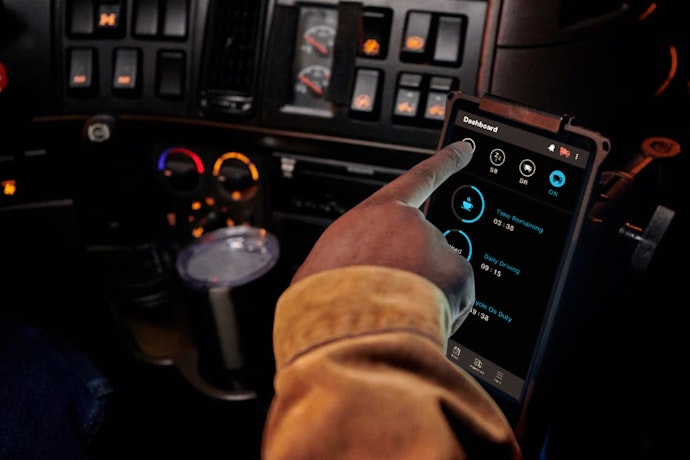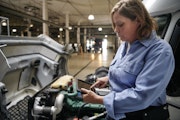How smart video fuels smart business
Learn how innovations in video powered by AI and machine learning are helping to reshape safety and efficiency for businesses.
Read more
The evolution of digital technology has impacted many industries, including transportation. Today, we live in a connected world—one where every new vehicle and asset will soon come standard with an internet connection allowing for integration into other systems, databases and vehicles. It’s been predicted that by 2020 approximately one in five vehicles will have some form of wireless network connection.1 And by 2022, 75% of vehicles manufactured are forecast to be connected cars.2 This includes the trucks, vans and other vehicles that comprise small, midsize and large fleets.
Let’s take a closer look at what a connected vehicle is, and how being connected can benefit fleet-dependent organizations.
Any vehicle with an internet connection is considered a "connected vehicle." But for a car, truck or van to truly function as a connected vehicle, an internet-enabled device and corresponding software applications must also be present. The vehicle itself must also allow for data to be transferred from the engine, chassis and electronics to the connected vehicle tracking device, for sending to a central data center or a driver’s smartphone.
Vehicle connectivity relies on a mix of built-in and after-market technologies. Most modern commercial vehicles come equipped with a factory-fit embedded telematics platform. through the installation of aftermarket devices that pair with built-in products to easily tie into a central data management system.
In general, operating a fleet of connected vehicles helps organizations better serve customers, bolster efficiency, promote safer driving habits and manage a more reliable return on assets and vehicles.
Specifically, using a telematics-based connectivity platform to integrate all fleet vehicles into a centralized repository and data stream helps fleets owners and drivers realize concrete benefits:
Asset utilization: Fleet managers can achieve smarter route planning by identifying assets stuck in traffic or locating a vehicle/driver/technician closest to an emergency or unplanned stop. They can also track utilization rates to monitor the efficiency of assets, allowing them to schedule optimal routes and gain a deeper understanding of how assets are performing. This leads to more efficient scheduling and dispatch across an entire fleet.
Compliance adherence: Fleet compliance comes in many forms. Data from connected vehicles can help owners ensure drivers are obeying road rules, taking required breaks, filing out the correct paperwork and performing appropriate safety checks. It can also help ensure goods that need to be transported in certain conditions, or within certain temperature ranges, are kept to those specific parameters. And with the ELD mandate now in effect, having telematics-based connectivity in place will better prepare trucks and drivers to adhere to new electronic reporting requirements.
Performance enhancement: Fleet managers can use vehicle data to help drivers monitor their performance in a number of areas including driving style, fuel efficiency, safety and productivity. Back office employees can more readily assign the best driver based on vehicle location and job status data.
Safety and maintenance Improvement: Using DTCs (Diagnostic Trouble Codes) directly from the vehicle’s ECM (Engine Control Module), telematics-connected vehicles can send diagnostic alerts to fleet managers for resolution of maintenance issues in near real-time. This helps avoid major downtime or costly repairs down the road. It also creates an in-depth record of vehicle health over time to ensure appropriate routine vehicle maintenance is carried out on schedule.
Connected vehicles also help drivers stay safe by sending audible alerts of upcoming hazards, including events such as traffic accidents or poor weather. And fleet managers can use data collected to make better decisions about how vehicles are used and how drivers are trained on the safe operation of all fleet trucks and cars. Given that the death toll of motor vehicle accidents in 2017 reached 40,1003, any information that helps fleet owners tip the safety scales in their drivers’ favor is invaluable.
Streamline office functions: Telematics-based connectivity supports electronic work orders. Data, including photos and signatures, can be uploaded as jobs are completed, with GPS verifying a worker’s or driver’s location. This reduces the time it takes to complete forms in the first place, and also the time it takes to catch up on paperwork once a job is complete.
The next phase of vehicle connectivity will be focused on componentization, defined as connecting all assets and products down to the component level to enable better performance and safer operation of new vehicles. This will allow automakers achieve better fuel efficiency and manage performance based on the type of load that is being hauled or terrain on which a vehicle is being driven.
Looking a little further ahead, telematics will soon be tied to smart city technology, such as vehicle-to-vehicle (V2V), vehicle-to-infrastructure (V2I) and vehicle-to-everything (V2X). V2V is a smart technology that enables data exchange from one vehicle to another based on dedicated short-range communications (DSRC). V2I captures data such as traffic congestion, weather advisories and bridge clearance levels, and then wirelessly transmits it to inform drivers of conditions for which they should stay aware. V2X technology makes every vehicle on the road smarter and safer by giving it the power to “communicate” with the traffic system, including other cars and infrastructure.
The impending arrival of universal 5G cellular connectivity will also greatly impact the quality and capability of connected vehicle communication. Faster processing and transmission of vehicle-related data will help further improve the operational safety and efficiency of every fleet.
Sources:
1http://www.gartner.com/newsroom/id/2970017
2https://www.smartcitiesdive.com/news/the-decades-long-evolution-of-the-connected-vehicle/448903/




Find out how our platform gives you the visibility you need to get more done.
Learn how innovations in video powered by AI and machine learning are helping to reshape safety and efficiency for businesses.
Read moreAre you ready for vehicle tracking? Go through our checklist to learn the signs you’re ready to add fleet tracking to...
Read moreLearn how AI, machine learning, and predictive analytics is improving fleet accurating and cutting costs.
Read moreLearn how telematics can lead to operational improvements.
Read more